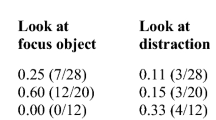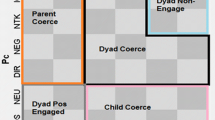Abstract
Analogue behavioral observations are an important component of multi-modal, multi-informant assessments. The Dyadic Parent-Child Interaction Coding System (DPICS) is a structured behavior observation system developed to assess the frequency and quality of parent and child behaviors during a structured dyadic interaction. The DPICS includes two, five-minute warm-up (WU) segments before coded segments; these WU segments are thought to allow dyads time to acclimate to observation instructions and improve the representativeness of sampled behavior. To date, there are no published studies addressing the usefulness of warm-up (WU) segments in a community-based treatment setting. This study analyzed the contribution of including WU segments in DPICS observations by comparing mean parent and child behavior composite frequency counts obtained from a community sample of 13 mother-child dyads. Comparisons were made between pre- and post-treatment DPICS WU and typically-coded (TC) segments. No significant differences were found between WU and TC segments at pre- or post-treatment DPICS observations. The implications of our findings for the utility of WU segments are discussed, along with suggestions for future directions in research.
Similar content being viewed by others
References
Bagner, D., & Eyberg, S. (2007). Parent-Child Interaction Therapy for disruptive behavior in children with mental retardation: a randomized controlled trial. Journal of Clinical Child and Adolescent Psychology, 36, 418–429.
Bagner, D., Fernandez, M., & Eyberg, S. (2004). Parent-Child Interaction Therapy and chronic illness: a case study. Journal of Clinical Psychology in Medical Settings, 11, 1–6.
Bessmer, J. (1998). The Dyadic Parent-Child Interaction Coding System II (DPICS II): Reliability and Validity with Mother-Child Dyads. Unpublished doctoral dissertation, University of Florida, Gainesville, Florida.
Bessmer, J., & Eyberg, S. (1993, November). Dyadic Parent-Child Interaction Coding System II (DPICS II): Initial reliability and validity of the clinical version. Paper presented at the AABT Preconference on Social Learning and the Family, Atlanta, GA.
Brestan-Knight, E., & Salamone, C. (2010). Measuring parent-child interactions through play. In S. Russ & L. Niec (Eds.), Play in intervention and prevention. New York: Guilford Publications, Inc.
Brooks, S., Wilsie, C., Thornberry, Jr., T., Lambha, M., & Brestan-Knight, E. (2009, November). Characteristics of Parent-Child Interactions Involving Children with Autism Spectrum Disorder. Poster presented at the 43rd Annual Association for Behavioral and Cognitive Therapies Convention, New York, NY.
Chaffin, M., Silovsky, J., Funderburk, B., Valle, L., Brestan, E., Balachova, T., et al. (2004). Parent-Child Interaction Therapy with physically abusive parents: efficacy for reducing future abuse reports. Journal of Consulting and Clinical Psychology, 72, 500–510.
Chambless, D., Sanderson, W., Shoham, V., Bennet Johnson, S., Pope, K., Crits-Christoph, P., et al. (1996). An update on empirically validated therapies. Clinical Psychologist, 49, 5–18.
Chambless, D., Baker, M., Baucom, D., Beutler, L., Calhoun, K., Crits-Christoph, P., et al. (1998). Update on empirically validated therapies: II. The Clinical Psychologist, 51, 3–16.
Chase, R., & Eyberg, S. (2006). Abridged Manual for the Dyadic Parent-Child Interaction Coding System, 3rd edn. Retrieved May 13, 2010, from the Parent-Child Interaction Therapy website: http://www.pcit.org.
Choate, M., Pincus, D., Eyberg, S., & Barlow, D. (2005). Parent-Child Interaction Therapy for treatment of separation anxiety disorder in young children: a pilot study. Cognitive and Behavioral Practice, 12, 126–135.
Coursen, L. (2009). Frequencies of DPICS-III codes for a sample of 8 to 12 year olds. Unpublished honor’s thesis, Auburn University, Auburn, Alabama.
Deskins, M. (2005). The Dyadic Parent-Child Interaction Coding System II: Reliability and validity with school-aged dyads. Unpublished doctoral dissertation, Auburn University, Auburn, Alabama.
Eyberg, S., Nelson, M., Duke, M., & Boggs, S. (2005). Manual for the Dyadic Parent-Child Interaction Coding System, 3rd edn. Retrieved May 10, 2010 from the Parent-Child Interaction Therapy Web site: www.pcit.org.
Eyberg, S., Nelson, M., & Boggs, S. (2008). Evidence-based psychosocial treatments for children and adolescents with disruptive behavior. Journal of Clinical Child and Adolescent Psychology, 37, 215–237.
Foote, R. (2000). The Dyadic Parent-Child Interaction Coding System II (DPICS II): Reliability and validity with father-child dyads. Unpublished doctoral dissertation, University of Florida, Gainesville, Florida.
Hanf, C. (1969). A two stage program for modifying maternal controlling during the mother-child interaction. Paper presented at the meeting of the Western Psychological Association, Vancouver, British Columbia.
Haynes, S. (2001). Clinical applications of analogue behavioral observation: dimensions of psychometric evaluation. Psychological Assessment, 13, 73–85.
Hembree-Kigin, T., & McNeil, C. (1995). Parent-child interaction therapy. New York: Kluwer Academic/Plenum Publishing.
Mash, E., & Foster, S. (2001). Exporting analogue behavioral observation from research to clinical practice: useful or cost-defective? Psychological Assessment, 13, 86–98.
Mash, E., & Hunsley, J. (2005). Evidence-based assessment of child and adolescent disorders: issues and challenges. Journal of Clinical Child and Adolescent Psychology, 34, 362–379.
McMahon, R., & Frick, P. (2005). Evidence-based assessment of conduct problems in children and adolescents. Journal of Clinical Child and Adolescent Psychology, 34, 477–505.
McNeil, C., & Hembree-Kigin, T. (2010). Parent-child interaction therapy (2nd ed.). New York, NY US: Springer Science + Business Media.
Miller, E., & Eyberg, S. (1991). Parent-child interaction therapy with a diabetic child. In S. Boggs & C. Rodriguez (Eds.), Advances in child health psychology: Abstracts. Gainesville: Clinical and Health Psychology Publishing.
Mori, L., & Armendariz, G. (2001). Analogue assessment of child behavior problems. Psychological Assessment, 13, 36–45.
Nixon, R., Sweeney, L., Erickson, D., & Touyz, S. (2003). Parent-child interaction therapy: a comparison of standard and abbreviated treatments for oppositional defiant preschoolers. Journal of Consulting and Clinical Psychology, 71, 251–260.
Ridgeway, L. (2007). If you build it, will they come? The effectiveness and transportability of group Parent-Child Interaction Therapy (PCIT) with community families. Unpublished doctoral dissertation, Auburn University, Auburn.
Roberts, M. (2001). Clinic observations of structured parent-child interaction designed to evaluate externalizing disorders. Psychological Assessment, 13, 46–58.
Robinson, E., & Eyberg, S. (1981). The dyadic parent-child interaction coding system: standardization and validation. Journal of Consulting and Clinical Psychology, 49(2), 245–250.
Schuhmann, E., Foote, R., Eyberg, S., Boggs, S., & Algina, J. (1998). Parent-child interaction therapy: interim report of a randomized trial with short-term maintenance. Journal of Clinical Child Psychology, 27, 34–45.
Shanley, J., & Niec, L. (in press). The contribution of the Dyadic Parent-Child Interaction Coding System (DPICS) warm-up segments in assessing parent-child interactions. Child & Family Behavior Therapy.
Shrout, P., & Fleiss, J. (1979). Intraclass correlations: uses in assessing rater reliability. Psychological Bulletin, 86, 420–428.
Ware, L., Fortson, B., & McNeil, C. (2003). Parent-child interaction therapy: a promising intervention for abusive families. The Behavior Analyst Today, 3, 375–382.
Webster-Stratton, C. (1985). The effects of father involvement in parent training for conduct problem children. Journal of Child Psychology and Psychiatry, 26, 801–810.
Author information
Authors and Affiliations
Corresponding author
Rights and permissions
About this article
Cite this article
Thornberry, T., Brestan-Knight, E. Analyzing the Utility of Dyadic Parent-Child Interaction Coding System (DPICS) Warm-Up Segments. J Psychopathol Behav Assess 33, 187–195 (2011). https://doi.org/10.1007/s10862-011-9229-6
Published:
Issue Date:
DOI: https://doi.org/10.1007/s10862-011-9229-6




